A Mallorcan Visit
by John Nasci
Reprinted from "Crown Jewels of the Wire", December 2001, page 5
I had just returned from a successful trip to Sicily in late July where I was
able to retrieve four FIDENZA multi-parts (which have been recently given the new
designation of CD 378.7), when I received an E-mail from my Mallorcan friend
Magdalena. Over the past three years of our friendship, she had been trying to
convince me to come to Mallorca to visit her. So, after three years of
correspondence, I decided to make the trip to Mallorca. Of course, as a good
insulator collector, I had an ulterior motive for the trip ... the retrieval of
insulators. In particular, I hoped to find an ox-blood CD 680 of which I
understand there are only a handful known to the hobby and were found in
Mallorca.
So, with tickets in hand and backpack on back, I was off to that small
exotic island located in the Mediterranean Sea off the southeast coast of Spain.
Having traveled to southern Spain last December, I was prepared for cool
temperatures and packed accordingly. However, to my delight upon arrival at the
Palma de Mallorca airport, I found the weather to be sixty degrees and sunny and
that's the way it remained the entire ten days I was on the island.
As is
customary, the first few days of the trip were dedicated to spending time with
Magdalena and to meeting her friends and family. We also did some sight-seeing
and a great deal of hiking. One hike in particular was along paths created by an
18th century archduke who came from Austria to the island to get away from the
hustle and bustle of archduke life. He bought about seven miles of the
mountainous northern coast line of the island for the purpose of preserving the
land on which he created miles and miles of trails for people to come and enjoy
the beautiful landscape and scenery. That we did, thanks to him.
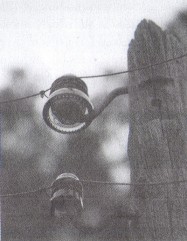
A broken amber CD 106 in
service below a CD 154 along
the Archduke's path.
Hiking along
the path among 500 year old olive trees and the pungent aroma of wild rosemary
and thyme, I noticed an open wire power pole line that followed the path over
the mountains to the sea. For the most part the line was constructed of wooden
poles with a pair of wires carried by insulators most of which were CD 154s (ESA
and Hemingray-42) and CD 470 ESAs. Near the end of the path, after about five
miles and seven hours of hiking, I spied a pole with interesting looking glass
on it. Upon closer inspection, I determined the insulator to be a dark amber CD
106, probably an ESA. Unfortunately the piece was in use, which normally would
have simply caused me to solicit the assistance of a local electrician, but it
also had a severely broken skirt. Therefore, I took a picture of the insulator
and caught up with my hiking party.
Upon hearing of my "unusual"
hobby, a friend of Magdalena informed me that she had seen insulators for sale
at a weekly mercadito, the Spanish word for flea market. So, on the third day of
my stay in Mallorca, we got up early and drove to a nearby town to explore the
mercadito. Upon entering the flea market, almost immediately I found three CD
106 ESAs in dark green aqua but the seller wanted about ten dollars per
insulator so I thought I would see what else I could find.
After perusing most
of the rest of the market area I was starting to lose hope of finding anything
else but upon turning the comer into the last row of booths, I found a seller
who had a box of 20 or so insulators of various colors. Much to my delight he
only wanted about $3.00 a piece for them. The seller was surprised to hear that
there were people who collected insulators. He sold them mostly to people who
bought them for decoration. Included in the lot I decided to buy were several CD
106 ESAs in dark green aqua. Most of them were simply embossed
"E.S.A." but one was marked "ESPERANZA" and another was
embossed faintly "ESPERANZA SA" over a more pronounced
"E.S.A." on one side and "JTE-F-60102" on the other side, an
unlisted embossing. Additionally I walked away with two unembossed CD 106s in
purple and one in straw. The seller told me he had more purple ones but
unfortunately none in amber. However, he told me that he wouldn't have any more
until the following week at which time I would be on my way back to the states.
So, I decided that they would have to wait until my next trip to the island.
After spending the first few days with my friends, I was on my own. With my new
found freedom, I decided the first order of business was to head to Palma de
Mallorca, the largest city on the island and take the Tren de Soller, a vintage
electric narrow gauge railway to the town of Soller located in the northern
mountainous region. It was a pleasant but bumpy hour long ride out of the city,
through the tangerine groves and into the mountains where we traveled through a
seven mile tunnel which delivered us to a spectacular vista high above the town
of Soller at the other end of the railway. Keeping my eyes open for insulators,
I was a bit disappointed because, being a glass collector, all I saw was white
porcelain. Nonetheless, I made some notes about downed poles along the tracks and took in the
scenery.
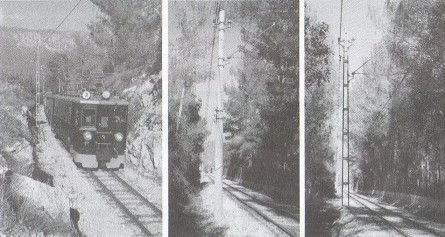
"Tren de Soller" Railway had some old concrete poles still in
service,
but typically the line construction used steel poles.
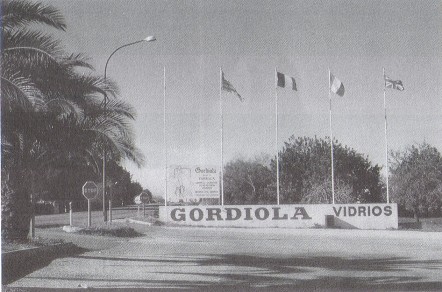
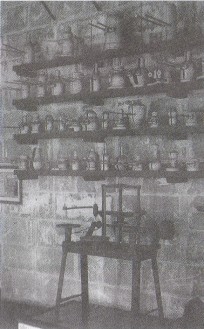
The next day I rented a car and took in the Gordiola Glass factory
located in my friend's town. Gordiola's history goes back over several hundred
years but unfortunately does not include the manufacture of insulators. However,
there was a very nice museum which included an historical collection similar to
that which is on display at the Corning Glass Museum, albeit very much smaller
and a wall of shelves containing hundreds of steel glass molds
(above), many of which are still in use by the
glass artisans (below) at Gordiola.
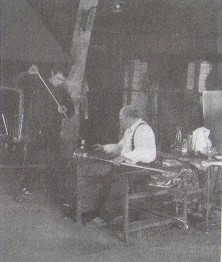
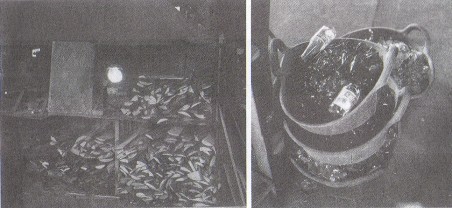
A very delightful aspect of the factory is
that they allow visitors to observe the glass items being made by the artisans and that visitors may walk very close to the furnaces (above left) and the
artisans as they are working. Positioned in spots near the furnaces were buckets of broken glass
sorted by color which are used to produce the raw glass for the artisans (above
right). I was hoping to see the production of raw glass but unfortunately they
were not making glass that day.
After visiting the glass factory, I drove north
to the Tren de Soller railway and to the locations I had made notes of the day
before. Having reached the railway, I found a place to park the car and hiked along the
tracks for about a mile or so. Almost immediately and all along the tracks, I
found downed concrete poles that were extremely deteriorated and laying parallel
to the tracks. The poles were probably the original structure for carrying the
overhead electricity that powers the train. They also supported a lower voltage
three phase AC circuit that was carried by a set of three small white porcelain
insulators with a groove in the top. Unfortunately, all the insulators were
either broken or missing from the downed poles.
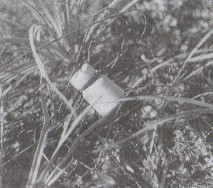
About a half mile into the hike,
I caught a glimpse of a coil of rusty steel wire off to the side of the tracks
and partially submerged in the ground. In hopes of finding an insulator still
attached, I decided to check it out. Upon pulling the coil out of the ground, my
hopes were confirmed as one of the white porcelain ponies was still attached to
the wire. The insulator (above) was extremely stained with rust from the steel
wire but upon closer inspection I detected a small logo marked on the top
resembling three interconnected polygons with a line underneath.
After returning
to the car, I decided to try another spot which I noted the day before. After
another nice mile or so hike, I was able to find two more white porcelain
ponies, both still on the downed poles. I was surprised that it took very little
effort to get them off as they were installed on the steel pins over a cloth
wrapped around the pin.
Having mixed success and with the day starting to wane,
I decided to drive back to my friend's house and try my luck again the next day.
On the return trip, I noticed a group of buildings next to the road that
appeared to be some kind of electric power facility. Upon entering the driveway,
it quickly became apparent to me that the place was abandoned so I parked the
car and started exploring. As I looked around, I determined that the place was a
power switching station and work yard. What a find! On the ground in the front
of the facility were four wooden poles each containing three CD 470s cemented
onto steel side pins. As much as I tried, there was no way that the insulators
were going to simply twist off. Frustrated with my failed attempt to remove
them, I gave up and started looking around the rest of the yard. Nearby, I found
a steel bracket containing four smaller brackets of three white porcelain
"spooks", many with "spook" hardware on them. I was able to
unbolt and remove one of the individual brackets and placed it in the car.
It was hard to avoid kicking up pieces of white porcelain insulators of all
types as I continued to walk around the grounds of the facility. On the
buildings were several different CDs all of which were out of reach without the
help of a ladder. The largest building had several large stalls which were used
for different purposes. Upon entering the last of about ten stalls, I discovered
what I had hoped would be there ... the supply shelf. BINGO! On the shelf were
two CD 372s, three CD 380s, a CD 523 on a metal side pin and numerous unmarked
white porcelain insulators with a grooved top a bit larger than those I found
along the Tren de Soller Railway. These insulators had probably never been used.
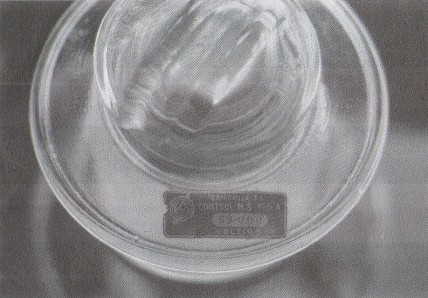
Upon further inspection of the CD 380s, I noticed that they still had the ESA
labels on them. The label is rectangular and red with white lettering. From top
to bottom of the logo is written "ESPERANZA, S.A." over "CONTROL
M.S. 105 A" over "59,000" (inverted color - red lettering on
white background) over "VOLTIOS". To the left of the text on the label
is the ESA logo which consists of two concentric circles inside of which are the
letters "E" and "A" rounded to fit in the circles with the
letter "S" depicted by a lightning bolt going through the middle of the
logo diagonally. Needless to say, I grabbed as many insulators as I could stuff
into my back pack and headed for the car.
Determined to fill my backpack again,
the next day I returned to the abandoned power plant with a newly purchased
hacksaw and retrieved five of the CD 470s that I was not able to get the day
before and an additional two CD 575s from the side of one of the buildings.
Although to this point my trip had been successful insulator-wise, my
interest in insulators and electrical construction techniques kept my eyes
watching the pole lines as I explored the rest of the island. As I drove from
town to town, I noticed an abandoned two wire power line which appeared to run
from each town to the next. The insulators that were used on the lines were
mostly white porcelain and of several different styles. The one style in
particular that caught my attention was a "gingerbread man". This was
the first time I had ever seen this style of insulator in the field. So, I kept
my eyes on the line I drove down the road in the hopes of finding something I
could take home with me. I eventually came to a spot where the line had crossed
the road. However, the line had broken and was hanging in the trees. Much to my
surprise, I found an insulator still attached to the wire. I pulled the car up
to it and was able to retrieve it without exiting of the car. Not having any
expertise in porcelain insulators, I would best describe the insulator as a very
fat pony with an inner skirt and a round top like the head of a screw with a
groove in the top.
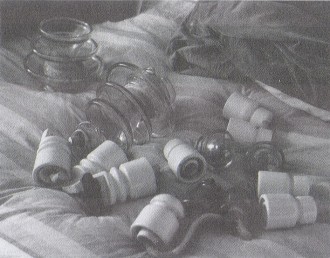
With about 30 insulators in my possession, my bags about full and my trip
almost over, I decided to take my mind off insulators and enjoy the remaining
few days of my stay in Mallorca and that I did.
In the long run, I wasn't able
to find any oxblood CD 680s, In fact I didn't even see any CD 680s of any color
or for that matter any glass t-bars whatsoever. But having caught a glimpse of
an amber CD 106 in the field, my hopes are kept alive for discovering one
intact either in the field or at a flea market when I next visit the beautiful
island of Mallorca. I only hope I find the amber beauty before someone else
does.
| 